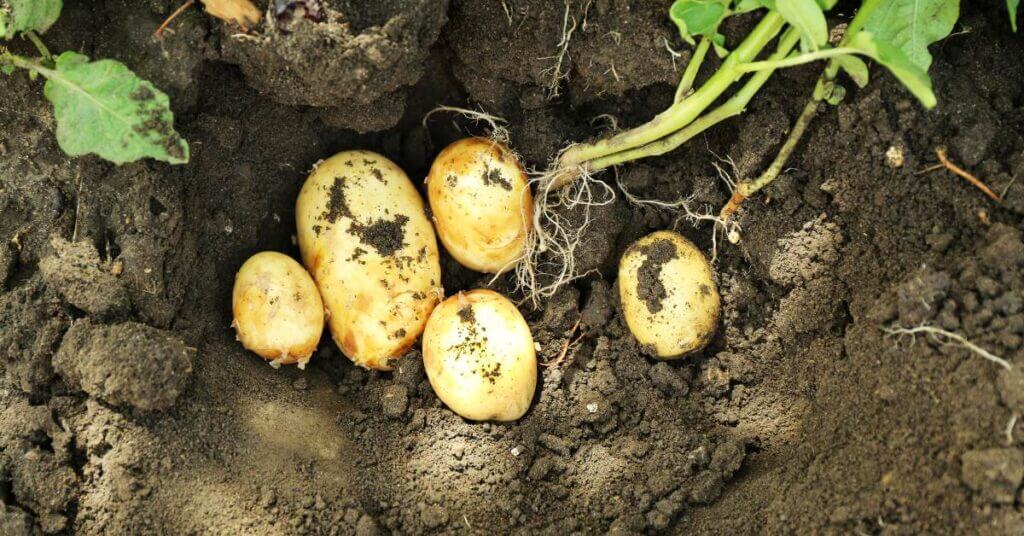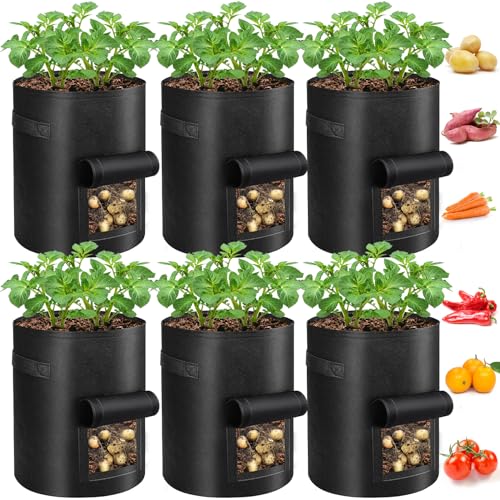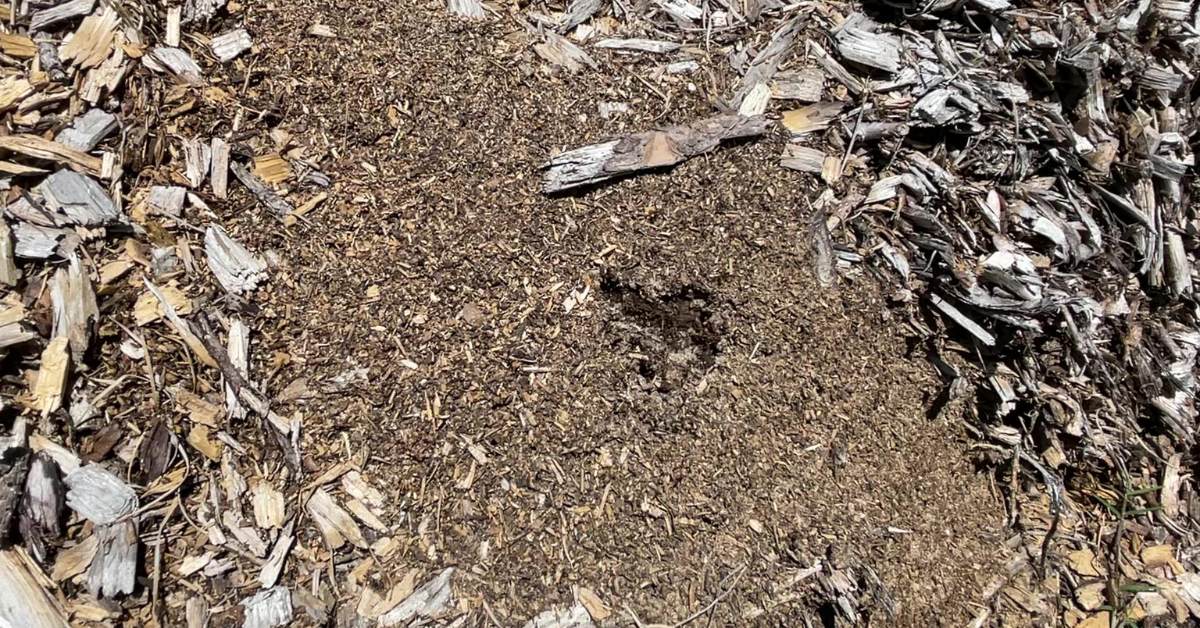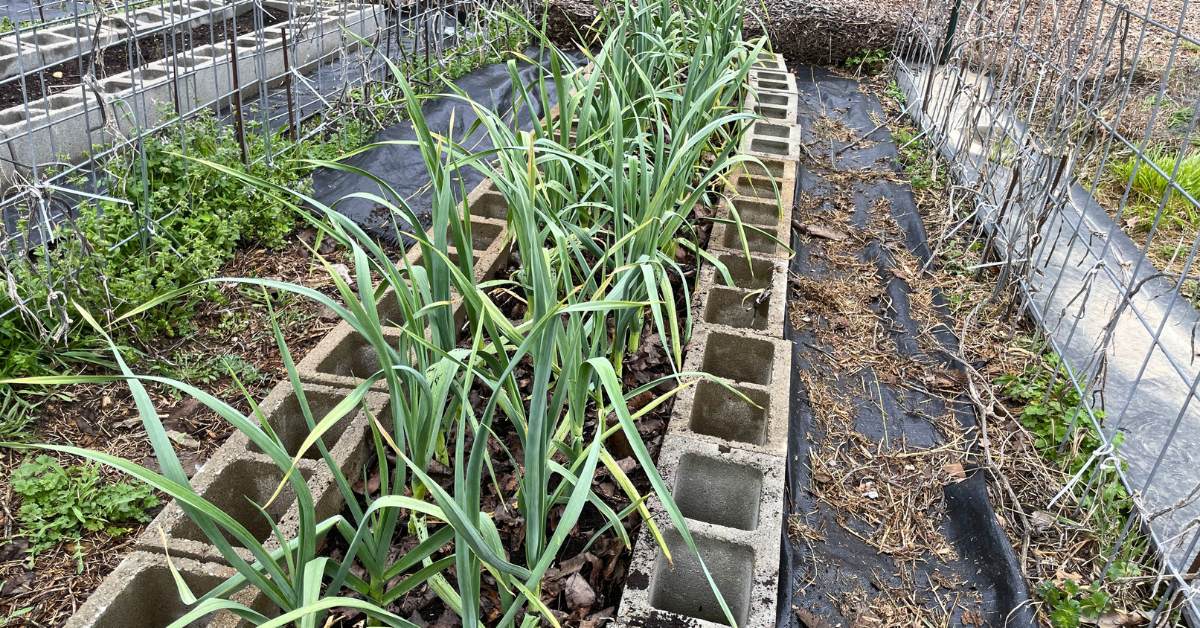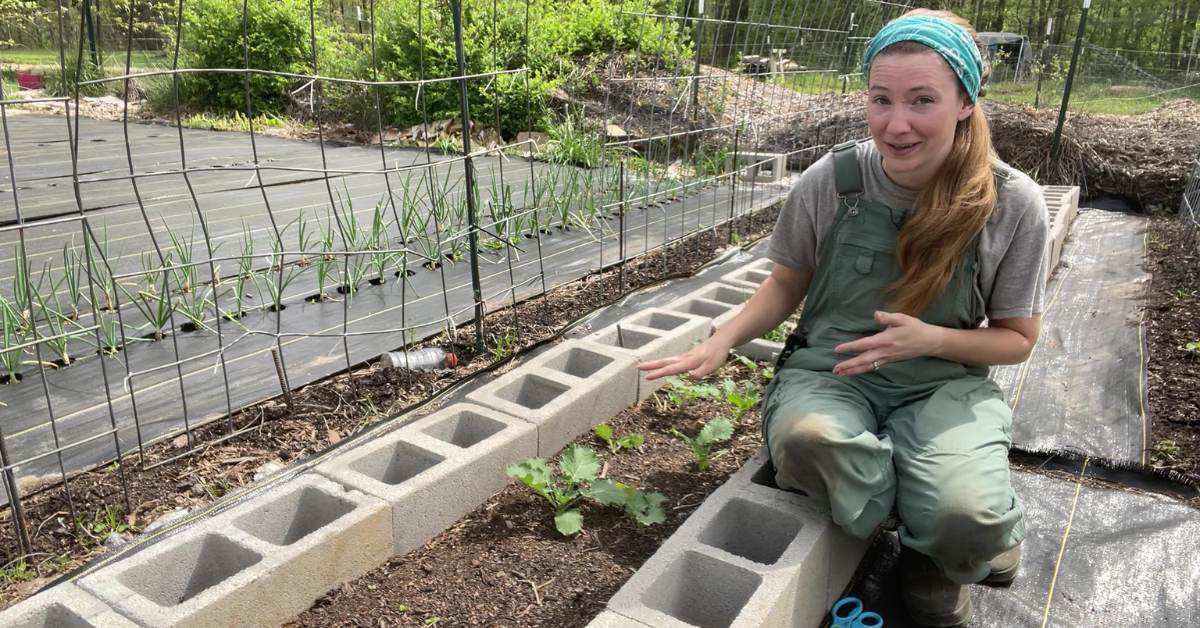Want to grow potatoes? You’re in the right place because I’m a bit of a potato-growing fanatic.
In our backyard garden, we aim to grow around 150 lbs of potatoes per year.
If I can give one piece of advice, it’s this:
Focus on your soil. It will make or break your success.
With that said, let’s chat about soil types that will set you up for a successful potato harvest.
Best Soil Types for Potatoes
Choosing the ideal soil for your potato plants significantly impacts their growth and the yield of your harvest. Potatoes are easy to grow in sandy soils—ideally, sandy loam soils that offer a balanced environment—neither too dense nor too loose.
These soils ensure adequate drainage while retaining enough moisture to support the plants through their growth cycle. Well-drained soils are fundamental for preventing waterlogged conditions that can lead to root rot and other growth-inhibiting circumstances.
This soil type is ideal whether you’re growing grocery store potatoes, your own seed potatoes from the previous year’s harvest, or certified disease-free seed potatoes.
Read our step-by-step guide to growing potatoes.
Ideal Soil pH for Potatoes
Potatoes flourish in slightly acidic soil, with the ideal pH range falling between 5.0 and 6.0.
This specific environment encourages the absorption of essential nutrients, guarding against diseases like scab, which thrives in more alkaline conditions.
To ensure your soil meets these requirements, consider testing your soil pH before planting. Simple pH soil test kits are widely available and easy to use, offering a clear view of your soil’s current state.
Prices pulled from the Amazon Product Advertising API on:
Product prices and availability are accurate as of the date/time indicated and are subject to change. Any price and availability information displayed on [relevant Amazon Site(s), as applicable] at the time of purchase will apply to the purchase of this product.
If results show your soil is too alkaline, try incorporating sulfur to help lower the pH.
On the other hand, if the soil is too acidic, add lime to raise the pH level.
Adjusting the soil’s pH gradually is key, as radical changes can disrupt plant health. Monitor and amend the soil periodically for the best results, creating the perfect environment for your potatoes to grow and thrive.
Soil temps play an important role, too. Here’s our guide to ideal soil temperatures for potatoes.
Proper Soil Drainage Is Key
Potatoes demand well-drained soil to fend off diseases like root rot. If the soil doesn’t drain well, water lingers around the roots, creating an environment that’s ripe for disease.
Here’s an ideal watering schedule for potatoes to help you strike that fine balance.
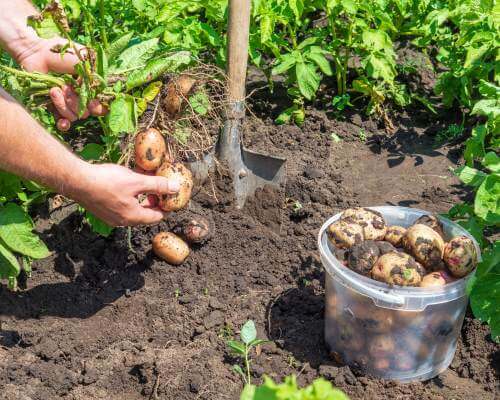
To ensure your garden offers the best condition for potatoes, take preventative steps:
- Add organic matter: Mixing in compost or aged manure improves soil structure, allowing water to flow more freely.
- Create raised beds: Elevating your planting area ensures water drains away from potato roots efficiently.
- Use sand: For heavy, clay-rich soils, blending in sand can enhance drainage, preventing water from pooling.
- Install drainage systems: In extremely problematic areas, consider installing French drains or similar systems to divert excess water away from your garden.
By focusing on these measures, you give your potatoes the well-drained environment they need for healthy growth, which paves the way to a rewarding harvest of homegrown potatoes.
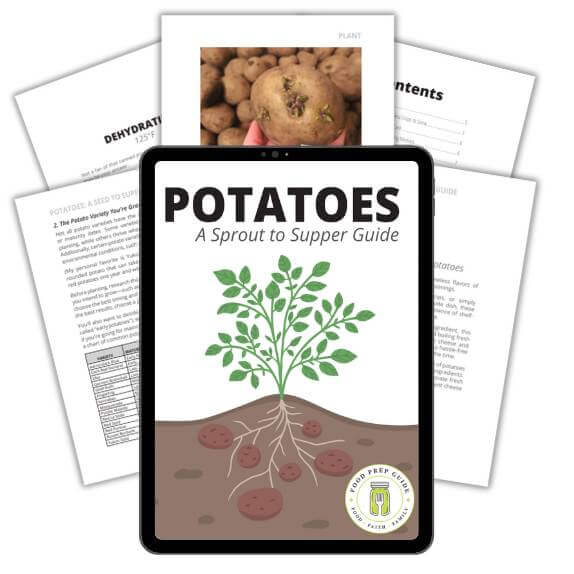
Master Potatoes From Seed to Table
Get growing & preserving faster with no-fluff tutorials for every step from plant to plate!
Best Ways to Amend Your Soil for Growing Potatoes in Ground
For potato plants to flourish, your ground soil needs a healthy boost. In most cases, you’ll want to mix in organic matter, such as compost or well-rotted manure into the top few inches of soil. This practice not only improves soil structure, making it more friable for young roots, but also ramps up fertility. Nutrient-rich soil is a springboard for robust potato growth.
- Add compost: Incorporates essential nutrients back into the soil and helps retain moisture.
- Work in aged manure: Offers a natural, high-quality source of nitrogen and other minerals.
- Include green manures: Cover crops like clover or alfalfa fix nitrogen in the soil, preparing it for your next potato crop.
Each of these amendments not only feeds the soil but also promotes good drainage and aeration. Considering potatoes despise waterlogged roots, well-amended soil ensures a healthy, productive environment for your tubers.
That said, none of this matters if you don’t plant potatoes at the right time. If you need help with that, here’s our guide to knowing when to plant potatoes.
Best Soil for Growing Potatoes in Containers
If you’re growing potatoes in pots, a grow bag, or some other large container, you need a soil mix that walks a fine line between retaining moisture and draining excess water.
In general, a blend of peat moss, compost, and perlite or vermiculite will provide the perfect balance.
Prices pulled from the Amazon Product Advertising API on:
Product prices and availability are accurate as of the date/time indicated and are subject to change. Any price and availability information displayed on [relevant Amazon Site(s), as applicable] at the time of purchase will apply to the purchase of this product.
Peat moss holds onto water, keeping the soil moist, which is crucial for the development of potatoes. Compost adds essential nutrients and organic matter that support healthy growth, while perlite or vermiculite ensures the soil doesn’t stay too wet, guarding against root rot and other water-related diseases.
You can also incorporate a slow-release organic fertilizer into the mix to feed your potatoes as they grow. This gives them a steady supply of nutrients without the need for frequent additional fertilization.
Remember, though, that too much of a good thing can be harmful, so follow the recommended rates on the fertilizer package.
Also, just a tip from an experienced gardener, container-grown potatoes are not the most prolific. You likely won’t get pounds and pounds of potatoes unless you plant dozens of grow bags, so plan accordingly.
Regardless of what growing method you use, whenever you’re ready to plant, here’s how far apart to space your potatoes for maximum growth.
Can you use regular potting soil for potatoes?
Wondering if the standard potting mix you find at garden centers is good soil for potatoes? Yes, it can be, but with adjustments for optimal results.
Regular potting soil provides a sterile medium, reducing disease risk and offering good aeration and drainage. However, potatoes have specific needs that regular potting mixes might not fully meet.
On the positive side, using potting soil means you avoid common soil-borne pathogens that can affect potatoes.
Not only that, but the consistency of potting soil also supports easy tuber growth, allowing new plants to expand without much resistance.
The downside, however, is that potting soil often lacks the nutrients potatoes crave for strong growth and high yields. It’s also designed to retain moisture, which can be a double-edged sword for potatoes that dislike overly wet conditions.
To bridge the gap, enrich the potting soil with a balanced mix of organic matter, such as compost and well-rotted manure. This addition boosts nutrient content and improves the soil structure.
Also, consider mixing in some sand to enhance drainage (for reasons we’ve already discussed).
Is Miracle Gro garden soil good for potatoes?
You might also wonder if Miracle Gro fits the bill for nurturing potatoes. This product, rich in nutrients, promises to support a wide range of plants, but potatoes have specific needs.
Miracle Gro is formulated to retain moisture, which is beneficial for many plants. However, for potatoes, excessive moisture retention could spell trouble, potentially leading to rot. That said, its nutrient-rich composition can give new potatoes a good start, provided you manage moisture levels carefully.
For most home gardens, you’ll still want to add sand or perlite to improve drainage.
All in all, Miracle Gro garden soil can support potato growth if you’re willing to make some adjustments!
Is raised bed soil good for potatoes?
Now this one is a hearty, yes! Soil that’s formulated specifically for raised beds has already accounted for the nutrients and amendments lacking from not planting in-ground. This type of soil is typically great for food crops like potatoes.
If you’re still planning your garden and potentially on the fence about raised beds, let me tell you why I love them, especially for growing potatoes.

Dream of Filling Your Pantry with Homegrown Staples?
Plan your garden with our FREE PRINTABLE—Staples Garden: What to Plant to Feed Your Family for a Year!
Raised beds warm up more quickly in spring than in-ground plots. This means you can plant potatoes earlier, giving them a longer growing season. This head start is crucial, especially in regions with shorter summer periods.
Plus, raised bed soil is typically well-aerated and drains efficiently. Since potatoes despise ‘wet feet’ and can easily succumb to rot, this is critical.
Also, controlling soil composition is straightforward with raised beds. Potatoes demand loose soil rich in organic matter but not too high in nitrogen, which can promote foliage at the expense of tuber development.
By filling your raised beds with a customized soil blend, you cater directly to the potato’s needs. You can adjust the mix to include ample compost and other organic materials, ensuring a fertile environment that fosters potato growth.
When it come to potato pests, raised beds can help minimize these threats (since pests often overwinter in the soil. By starting with fresh, clean soil, you can reduce the presence of harmful organisms.
Finally, the physical ease of raised bed gardening is a BIG pro. Tending to potatoes at a more comfortable height reduces the strain on your back and knees. Harvesting becomes a joy rather than a chore, as you can easily access the tubers without excessive digging and bending.
Overall, the convenience of raised bed gardening encourages attentive care, which translates to higher yields.
From improved drainage and soil warmth to ease of pest management and physical accessibility, the benefits are clear. Raised bed gardening for potatoes can be an especially rewarding approach for both new and experienced gardeners.
Since poor soil is the number one factor that impacts potato growth, success in growing potatoes starts with using the bet soil. It’s worth it to invest time in studying soil composition, so you can lay a strong foundation for growth. Your potatoes will be bigger and better for it!
When you’re ready, here are our guides that will help come harvest time:


